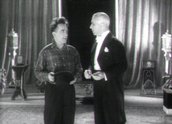


Let George Do It (1938)
Synopsis
Joe Blake (George Wallace) graduates from stagehand to performer at a vaudeville theatre after upstaging Mysto the Magician (Alec Kellaway). When he discovers that Molly (Gwen Munro), the girl he secretly loves, is going to marry the show’s producer, Joe and his mate 'Happy’ Morgan (Joe Valli) get drunk. Joe decides to commit suicide, so he commissions the gangster Elmer Zilch (Harry Abdy) to do the job, in exchange for being made the beneficiary of Joe’s will. The next day, Joe learns that he will inherit a fortune – but only if he can sign the legal documents at a certain date and time. Zilch’s men kidnap him and demand half the money. Joe escapes with the help of Clara (Letty Craydon), a large woman who has a major crush on him. They borrow a speedboat and make for the signing at Darling Point, on Sydney harbour, pursued by Zilch and his men. The documents are signed in the nick of time, and Joe marries Clara.
Curator’s notes
Let George Do It was George Wallace’s fourth film, but his first with Ken Hall and Cinesound. Wallace’s first three films were made in 1932-34, for Frank Thring’s Efftee Productions. After Thring’s death in July 1936, Hall proposed a collaboration to Wallace, to feature him in more action-oriented comedies. 'Wallace’s previous films, except A Ticket in Tatts (1934), had been more or less photographed stage revues’, Ken Hall wrote in his autobiography, Directed by Ken G Hall (1977). 'I wanted him in action comedy and it proved to be the right formula, because both his films for us were big box-office hits.’ (The second film was Gone to the Dogs, made in 1939).
Like his Efftee films, Let George Do It still relies heavily on the sort of comic sketches Wallace made famous in his 1920s vaudeville act, but it’s pushed along by the kind of thrilling outdoor action sequences that Ken Hall knew how to direct. Hall rated Wallace the best comedian Australia had produced. Both men were close to their creative peaks when they got together to make Let George Do It in 1938. Hall had made Cinesound into a movie factory in 'continuous production’, making three films a year, all of which made money. Wallace was a star on the stage, as well as the screen, and a popular drawcard. He was about 42 when he made this film, and he had been on stages since he was three years old, the child in his parents’ song and dance act. He had been a busker on the Sydney waterfront, a farmhand and canecutter in north Queensland, and a professional boxer, all before he joined a travelling road show at age 16, in 1911. His stage and screen persona as a country boy was thus partly informed by his own life and partly by watching other comedians, such as Charlie Chaplin, whose film work began in the US in 1913.
Wallace’s character in this film is a general stagehand, rather than a performer. He had used the same device in his first film, His Royal Highness (1932), partly because he always played characters at the bottom of the pile. Being a stagehand allowed a setting in which he could, at some point early in the film, demonstrate his unique style of dancing, singing and falling over. It may also have mirrored the kind of life he was leading when he joined the road show at age 16. He is said to have been a painter of scenery, mouth organist, odd-job man and even an acrobat in these shows. The 'stage drunk’ was a popular figure in Australian comic theatre. Wallace and Jack Patterson had played a pair of stage drunks for five years (as Dinks and Onkus), earlier in his career. They broke up in 1924, but we can get a sense of what the act was like from clip two, in which Joe Valli, a fixture in most Cinesound films, plays the companion drunk.
Let George Do It is generally seen as the peak of George Wallace’s film career. It’s certainly a more polished film than his earlier efforts, but it also captures Wallace in a range of his trademark styles – the singer, comic dancer, the acrobatic fool, stage drunk, and little Aussie battler who strikes it rich, without ever becoming too big for his (oversize) breeches.
- Overview
- Curator’s notes
- Video 3 clips
- Principal credits
- Find a copy
- Make a comment
- Map
- Add your review



